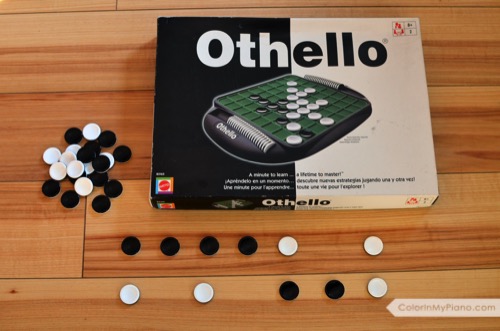Since attending Irina Gorin’s summer workshop for piano teachers in 2015, her “Tales of a Musical Journey” has become one of my favorite piano method books to use with beginners.
In her book, she uses black circles and white circles to represent simple rhythms in duple meter. (Duple meter is MLT’s term for when the macrobeat [big beats] contains two microbeats [little beats].)

Here is an example of Irina teaching with the black and white circles.
It’s easy to cut black and white circles out of paper, but I’ve also been using Othello chips. They are perfect for this because they are black on one side and white on the other. I found a used Othello game at a thrift shop for $2 a couple of years ago, and have been using the chips for rhythm games on the floor with my beginner students.

These chips can be used in any rhythm game where you might normally use rhythm value cards. Here are a few quick examples:
- The teacher notates two simple rhythm patterns (4 macrobeats in length), chants one of the patterns, and asks the student to identify which pattern they heard.
- Notate simple rhythm patterns and chant them together.
- Chant simple rhythms (perhaps using simple poetry) and notate them together.
The Othello chips also work great with a cloth staff/keyboard, which means the rhythms could be notated on the staff. There are many of fun uses for these chips! Let me know in the comments below if you have other ideas.



I’m intrigued, as I’ve been lamenting that I think 8th notes are easily understood at a younger age and are prevalent in our language, folk songs and rhymes, yet they don’t show up for SO long in most method books (and the ones that do I’ve not been happy with the content or duet parts). Since I heavily use content and curriculum from Gordon’s contemporary, Dr. Feierabend, this really appeals to me. Could you go into more detail for me when this method moves to standard notation or what level of other methods this would transition to? Or do her books go further?
Melissa, I absolutely agree with you: eighth notes are not difficult, and yet they are very delayed in most method books.
Irina’s book moves to staff notation gradually over the next few pages after those shown above in this blog post, using black and white circles without stems for a short time. Eighth notes are introduced a third of the way into Book 2.
So, the approach in Tales to a Musical Journey isn’t really consistent with an MLT approach to rhythm, but I still do appreciate the simplicity of the black and white circles at first!
I love the flipping Othello pieces! Beginning students could play a game of “I Spy” using their current pieces. The teacher builds a pattern with just quarter and half notes from a measure or phrase in their music and then they have to try to find where it occurs. I love having them use erasable colored pencils to mark patterns in their music so they can start seeing the “chunks” early on.
GREAT idea, Heidi! I love it! I’ll definitely be using your game idea with some students this week.